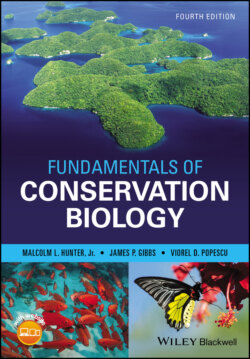Читать книгу Fundamentals of Conservation Biology - Malcolm L. Hunter Jr. - Страница 42
How Many Species Are There?
ОглавлениеCarolus Linnaeus, the Swedish biologist who founded modern taxonomy, described about 13,000 species in his 1758 opus Systema Naturae, but must have been well aware that this list was incomplete because in the eighteenth century much of the world remained unexplored by scientists. Today, over two centuries later, scientists have described over 1.8 million species using Linnaeus's system, to be exact 1,837,526 species as of May 2019, according to the primary source in these matters (Species 2000) (Fig. 3.1). Of course, this number grows daily and we can still only guess how many undescribed species there might be. Estimates of total species richness span from about 3 million to over 100 million, with one thoughtful analysis arriving at 8.7 million (plus or minus 1.3 million, Mora et al. 2011), but that effort was acknowledged to be inadequate for most microorganisms.
Figure 3.1 Over 1.8 million species have been described by scientists, and insects constitute over half this number. However, the estimated number of species is far greater, especially for smaller life‐forms.
We have known for quite some time that insects represent a substantial portion of the world’s biota, over half of all described species, with almost half of those insects being beetles. Biologists like to make this point with an anecdote about J. B. S. Haldane, a nineteenth‐century biologist (Gould 1993). When asked by a group of theologians what he had learned about God from having spent a lifetime studying His creations, Haldane is said to have replied, “He seems to have an inordinate fondness for beetles.” Although the scope for describing new beetles and other small animals remains enormous (Fig. 3.2), much of our attention in cataloging biological diversity shifted toward even smaller creatures following a classic study undertaken by a group of Norwegian microbiologists (Torsvik et al. 1990a, b). From two tiny soil samples – 1 gram of forest soil and 1 gram of marine sediment – scientists extracted first the bacteria and then the bacteria’s DNA. They then estimated the diversity of DNA strands, made a conservative assumption that bacteria are different species if less than 70% of their DNA is identical, and arrived at a rough estimate that each sample contained over 4000 species of bacteria, with little or no overlap in species between the two samples. Finding over 4000 bacteria species in a pinch of Norwegian soil was doubly impressive when you realize that, in 1990, 4000 was roughly the number of species of bacteria that had ever been described from all environments in the entire world. Today the number of described bacteria species has risen to about 10,000. Estimates of undescribed species still range greatly, up into the millions (Haegeman et al. 2013), with sizable numbers coming from the microbiome – the enormous suite of microbes that occupy the bodies of humans and other species (Huttenhower et al. 2012).
Figure 3.2 The depth of unexplored biodiversity is greatest among small species as exemplified by this amphipod (a), recently identified from the Antarctic Ocean, or this cave beetle (b) from China (from SUNY_ESF’s Top 10 New Species program: www.esf.edu/top10). Not all new species are small; in 2018 they also listed a new species of orangutan from Sumatra and a towering tree species from the coastal forest of Brazil.
([a] Cédric d’Udekem d’Acoz/Royal Belgian Institute of Natural Sciences; [b] Sunbin Huang and Mingyi Tian)
Finally, the number of species may be bolstered by the existence of sibling species or cryptic species, species that scientists cannot readily distinguish based on morphology but that are genetically distinct. Consider the case of a well‐known species of butterfly, Astraptes fulgerator, which may be ten different species, with nearly identical adults but visibly different caterpillars feeding on different host plants (Fig. 3.3) (Hebert et al. 2004; Brower 2006; Janzen et al. 2011). The morphology of adult genitalia (a primary way to identify insect species) gave no clue to the existence of these cryptic species. The idea of cryptic diversity received lots of press attention when an undescribed species, the Atlantic coast leopard frog, most readily identified by its calls, was discovered in New York City (Feinberg et al. 2014). The species had been lurking among other leopard frog species in New York city’s marshes for centuries before scientists recognized it as a unique species.
Figure 3.3 These caterpillars represent ten sibling species of what was long thought to be a single butterfly species, Astraptes fulgerator (Hebert et al. 2004). The interim names reflect the primary larval food plant and, in some cases, a color character.
(Dan Janzen/National Academy of Sciences, U.S.A)
Do we really need to know how many species there are? From a conservation perspective we do not even have the resources to address adequately the problems of a few hundred well‐known vertebrates and plants that are slipping toward extinction. Does it matter how many million other species we overlook? Certainly our efforts to understand ecology and evolution, the foundation of conservation biology, would be enhanced by a more complete taxonomy (Wheeler et al. 2012). And even if the number of species is of minor strategic concern, these estimates do convey two fundamental ideas. First, the number of species that may ultimately be at risk is enormous; in other words, we have a lot to lose. Second, we have a great deal yet to learn about the world.
